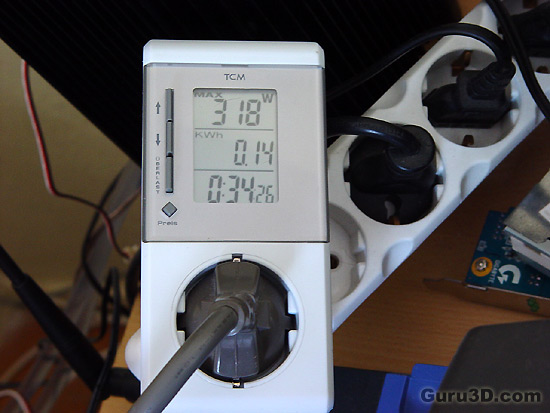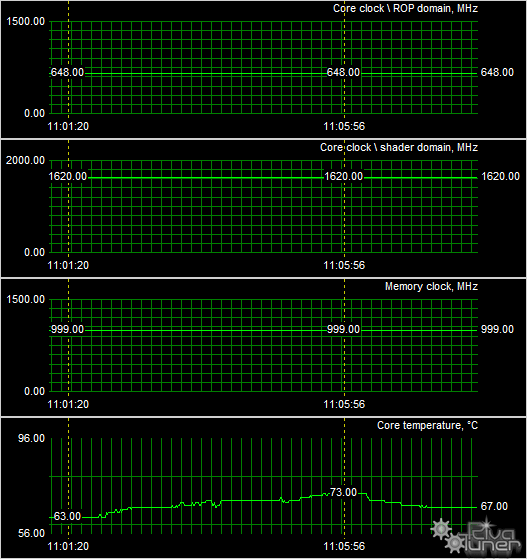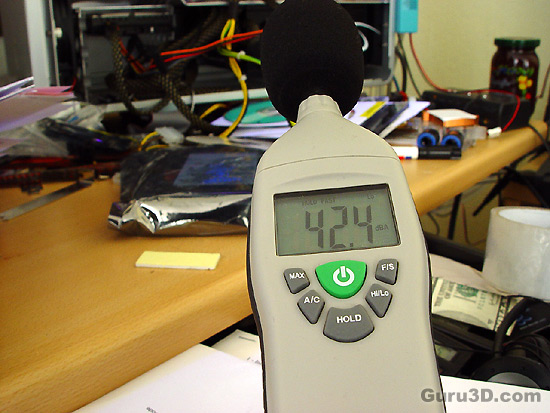Page 3
Le pouvoir "The Power"
We'll now show you some tests we have done on overall power consumption of the PC. Looking at it from a performance versus wattage point of view, the power consumption is not bad. Our test system is a Core 2 Duo X6800 Extreme Processor, the nForce 680i SLI mainboard, a passive water-cooling solution on the CPU, DVD-ROM and WD Raptor drive. Have a look
|
Videocard |
100% load |
System Idle |
|
BFG GTS 320 MB OC |
309 |
164 |
|
Calibre P880LV GTS 320 MB |
318 |
169 |
| XFX Fatal1ty GTS 320 MB | 323 | 174 |
The methodology is simple: we look at the peak wattage during a benchmark session with hefty IQ settings to verify power consumption. It's a good load test as both GPU and CPU are utilized really hard here. Please do understand that you are not looking at the power consumption of the graphics card, but the consumption of the entire PC.
We had a total system wattage peak at roughly 323 Watts for the Fatal1ty card, which is a lot but not excessive.
We simply place a wattage meter in-between the PSU and power socket. It's not the most objective way to test as you have to consider PSU efficiency as well, but it's the closest thing we can do though, and it measured pretty reliably and constant. Below is an example photo on how we measure:
 |
||
Here's the Guru3D.com power supply recommendation for the GeForce 8800 GTS:
- A single GeForce 8800 GTS requires you to have a 450 Watt power supply unit at minimum if you use it in a high-end system. That power supply needs to have (in total) at least 26 Amps available on the 12 volts rails.
- A second GeForce 8800 GTS installed on this system (SLI mode) requires you to have a 600 Watt power supply unit at minimum if you use it in a high-end system. That power supply needs to have (in total) at least 36 Amps available on the 12 volts rails.
There are many good PSU's out there, please do have a look at our many PSU reviews as we have loads of recommended PSU's for you to check out in there. What would happen if your PSU can't cope with the load?:
- bad 3D performance
- crashing games
- spontaneous reset or imminent shutdown of the PC
- freezes during gameplay
- PSU overload can cause it to break down
Les températures de la carte graphique
Let's monitor temperatures. We measured at a room temperature of 22 Degrees C.
 |
||
Now a normal 8800 GTS 320MB card idles at roughly 50 Degrees C and can get to 70-80 degrees C when fully utilized. You'd figure that a card with a HUGE overclock like this one has would run much warmer right ? Nope.
Despite the faster core frequency on the card, temperatures were pretty darn cool. The card is idling at roughly 55-60 degrees C and the highest temperature we measured with the GPU under full load was 73 Degrees C. Quite frankly this is really good compared considering it's using a standard NVIDIA cooler. Very puzzling, are some of the yields on this chip that good ?
But cooling wise, not bad at all. Does it make a lot of noise then ?
Noise Levels coming from the graphics card
When graphics cards produce a lot of heat, usually that heat needs to be transported away from the hot core as fast as possible. Often you'll see massive active fan solutions that can indeed get rid of the heat, yet all the fans these days make the PC a noisy son of a gun. I'm doing a little try out today with noise monitoring, so basically the test we do is extremely subjective. We bought a certified dBA meter and will start measuring how many dBA originate from the PC. Why is this subjective you ask? Well, there is always noise in the background, from the streets, from the HD, PSU fan etc etc, so this is by a mile or two not a precise measurement. You could only achieve objective measurement in a sound test chamber.
The human hearing system has different sensitivities at different frequencies. This means that the perception of noise is not at all equal at every frequency. Noise with significant measured levels (in dB) at high or low frequencies will not be as annoying as it would be when its energy is concentrated in the middle frequencies. In other words, the measured noise levels in dB will not reflect the actual human perception of the loudness of the noise. That's why we measure the dBa level. A specific circuit is added to the sound level meter to correct its reading in regard to this concept. This reading is the noise level in dBA. The letter A is added to indicate the correction that was made in the measurement. Frequencies below 1kHz and above 6kHz are attenuated, where as frequencies between 1kHz and 6kHz are amplified by the A weighting.
|
|
|||||||||||||||||||||||||||||||||||||||
|
|||||||||||||||||||||||||||||||||||||||
We take the dBA meter, move away 75 CM and then aim the device at the active fan on the graphics card. We measure roughly 42 dBa which is to be considered a quiet noise level coming from the PC yet also a norm as most of our tests end up at this sound level. Again, this is a very subjective test and that dBa level includes all noise in the environment.
That's as much "noise" as any reference cooled product. Quite good, below is an example photo of how we measure.

